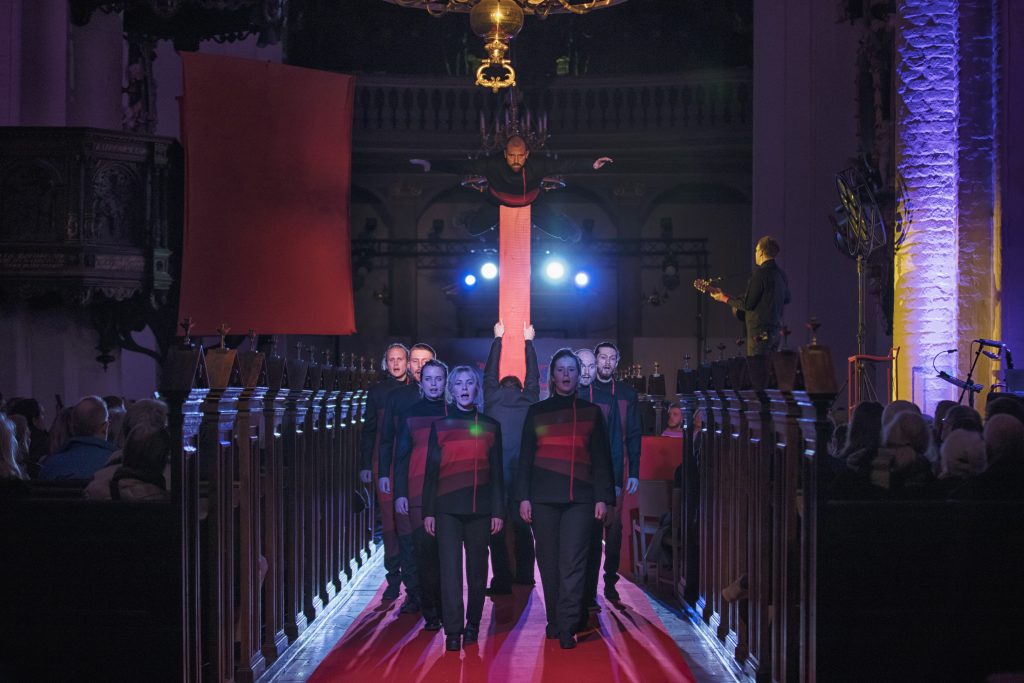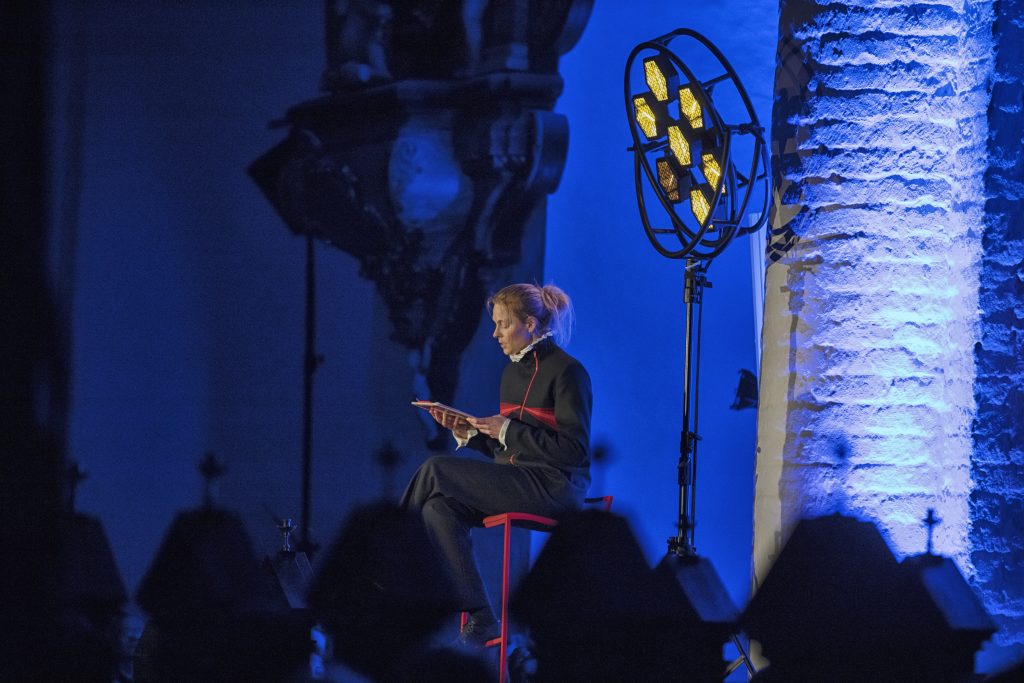Maybe God is dead, but His church is alive. At least in Denmark. This has to do with what you might call the Danish paradox of faith: a highly secularised society with a Lutheran Folkekirke (=Folk Church) supported by a large majority of the population [hints]American sociologist Phil Zuckerman has written a nice book on this aspect of Denmark (and also a bit of Sweden): Society without God (2008) Phil Zuckerman[/hints]. Although that majority can hardly be found in church on Sunday mornings.
But marriage and mourning are done in church. And if you have a child, you register it at the parish office, because that is what part of the civil registry in Denmark does. In other words, the church is an extension of society in a very practical way. For the state as a registration office, and for the average Dane as a collection point for the highlights of your life.
Art frees God
In the Danish city of Aarhus, this year's European cultural capital, tickets for Befri gudstjenesten (= liberate the worship service) then sold out in no time. The cathedral, in collaboration with theatre Svalegangen from Aarhus, would give a taste of what you could change about an average Lutheran service.
Domprovst Poul Henning Bartholin, who heads Aarhus Cathedral Church and the other Lutheran churches within the city, came up with the idea for such a cross-border service.

'In Aarhus in 2015, we were brainstorming how we would celebrate Luther Year two years later. [hints] 1517 is the year when the Reformation started, when Martin Luther nailed 95 theses on religion to the door of his church in Wittenberg.[/hints] When we realised that the Luther year coincided with the year when Aarhus would be European Capital of Culture, we started thinking about how to combine it. That's how we got talking to Per Smedegaard of theatre Svalegangen.'
Honour as a stumbling block
'It soon became clear that a biographical or historical depiction of the person Luther was not going to be very appealing to many people. Then we philosophised on. What does Luther mean? What did Luther want? He wanted to remove the church as an institution between man and God, he saw the church as a stumbling block. Then Per (of Svalegangen) said: actually, the service is such a stumbling block for me. The language, the fact that you sit behind each other and don't see each other, instead of standing or walking.' [hints]That sitting in a church, by the way, is something that came into the church only later. In old churches, you can still see that there were masonry seats along the walls, but that was for the elderly. The rest of the congregation just stood. [/hints]
Thus the plan was born to completely ransack the existing worship service and free it from, so to speak, old forms and thoughts. It was Luther who pointed out that a church that clings to old forms distances itself from its worshippers. Therefore, we wanted to try out how to use new forms in the church.'
Struggling pastor
And a multitude of new forms tumbled over the church-goers at the premiere. The performance starts small, intimate almost. A small, red-lit passage leads the audience into the church, where a few singers sing snatches of music, with a long-held chord from the organ in the background.
The rest of the church is still screened off at that time. Over the course of the service, the church is increasingly used, and surely the highlight is at the end, when a nearly 100-strong gospel choir walks in at the end of the service and 'I Will Try To Fix You' By Coldplay sings.
But there are more surprises along the way. The pastor's introduction, for example. A woman appears, she is literally in her (over)shirt, and speaks of anxiety: 'Who are we? What is the meaning of life?' She struggles with words and also literally with the helpers, who seem to overwhelm her but suddenly raise her above themselves and the audience. She keeps her arms spread wide, like some kind of Jesus figure. The audience holds its breath. They put the frail pastor down again, who is handed a short coat. Her shirt disappears under the uniform jacket and so Reverend Christina Laursen crawls into her role.
(Rehearsal footage from Aarhus Stiftstidende here)
'Fader vor!'
As the audience stands recovering from this emotional intro, the small choir emerges, smiling. They stick out their fist. And slap it on their hearts. And then on their thigh. A sort of hand-clapping game ensues in which audience members begin to join in, laughing at first but then enthusiastically. All of this happens without words, until one of the choir members starts chanting to the beat: 'Fader vor! Du som er i himlene!'
In Danish, that is the beginning of the our father. We are home again, most people know that.

Not everyone joins in. A man next to me in an orange jacket looks at all this as petrified. And he doesn't look happy about it either. But for most it works infectiously, liberating almost after the somewhat disorienting, sombre beginning. Almost seamlessly, the Our Father turns into a performance by rapper Per Verse , which the text of Ecclesiastes 3:1-8 taken in hand.
Beef heart and green tea
Then it is time for Holy Communion, the symbolic act of sharing food and drink with which Jesus made a pact with his followers: if you do this, in remembrance of me, I will be with you again for a while. The audience walks deeper into the church, where there is a table with chalices of green tea, and a table with earthenware crucibles. Ragout of beef heart is the contents (artichoke heart for the vegetarians). Courtesy of restaurant Gastromé - one of the top culinary restaurants in Aarhus, awarded a Michelin star.
Meanwhile, the pastor stands in the middle of the aisle in front of a large barrel of pappadums and hands them out. People are short of hands to accept and devour the good gifts. You don't expect it in a church. The ragout smells delicious, singers and musicians play a medley of hymns by Martin Luther. Slowly we return to the front of the church where the pews are. Back to the comfort zone of an 'ordinary' service.

Dancing with a plank
Although there are still occasional disruptive elements. Dancers of physical theatre Don Gnu accompany parts of the liturgy by a kind of fight dance down the middle aisle of the church. Or by a dance/balance exercise for two men with boards. And yes, that looks as crazy as it reads.
But there is a reflection - regular element of a service. Or actually there are two: a talk by stage actor Rønne on faith, and by pastor Christina Laursen on atheism. Rønne points to the elements that Judaism, Christianity and Islam have in common, the children of Abraham as Rønne says. By this he refers to the patriarch that all three faiths have in common. What are the similarities? Where can these faiths recognise themselves in each other?
What is missing is the reading from the Bible. There is a creed, but it is brand new, devised by Christina Laursen.

And there is music. Lots of music.
Fællessang
Little organ, a lot of singing, that is in short the conclusion about the music in this groundbreaking service. Largely singing by nine choristers, already singing chunks of popular Danish music as they enter, held together by the organ playing a keynote around which all the bits of singing swirl.
There is the ensemble Den Danske Salmeduo, which plays instrumental jazz versions of psalms and hymns.
And there is fællessang, singing together - the backbone of Danish togetherness. No party, almost no meeting even, goes by without a communal song sung. Film company Zentropa does it. The Danish parliament does it. And in church there is no escape at all.
The core of fællessang is the recognition of golden oldies, but this performance would defeat its purpose if no innovation took place here too. That's why a classic song like Altid Frejdig (a chant that has an extra charge in Denmark as the anthem of the Danish resistance in World War II) on the kick. And the indie/reli band Kloster brings a whole new chant, Når dagen sænker ned, to be found from May this year in the newly published Book of Songs. Tonight, it can be heard in a church for the first time. With the help of a short practice session and a powerpoint, the cantor guides the audience through it.
The epitome of fællessang is the previously mentioned I Will Try To Fix You by Coldplay, which thundered immersively through the church at the conclusion of the service with the organ, musicians, gospel choir and audience at full volume.
No real service
As a dramatic performance, the 'new service' succeeded well. The lighting effects, the music, the mix of familiar and new, the gimmick of a starred restaurant providing Holy Communion, the way the audience is drawn into the performance by joining in - it convinces. As a performance. But even with each new element, you wonder: will this last? Ragout and green tea? The new costumes of the vicar and her helpers?
The audience's reactions afterwards have been mostly positive. And that can domprovst Bartholin agreed after two performances.
"We have had a lot of positive reactions to the performance. I also didn't expect the performances to sell out so quickly. But there has also been criticism. Many people were angry because a female imam was a speaker in one of the performances. But she wasn't preaching, she was invited to talk about fællesskab (togetherness). And, perhaps needless to say: it is not a real service. Also, believers missed Jesus Christ in the creed. He is not mentioned at all in the new version. Furthermore, people felt that the language was not beautiful, and that the content was too superficial."
What is allowed to stay?
Would you take elements from the performance service?
"Implementing things one-on-one is not possible, a lot of preparation within the church as a whole precedes that. In addition, the dressing of the church, as it is during the performance, also plays a role. Without the light, the singers, the use of the church by walking or sitting, much of the atmosphere falls away. And thus also the effect of such a loose element."
Which elements of the performance would u want to keep?
"I would like to continue working on different things. For example, the order, the construction of a service, as it was in the performance. First build a sense of belonging through a communal act, like in the performance through Holy Communion. Or through a baptism. And then the deepening."
